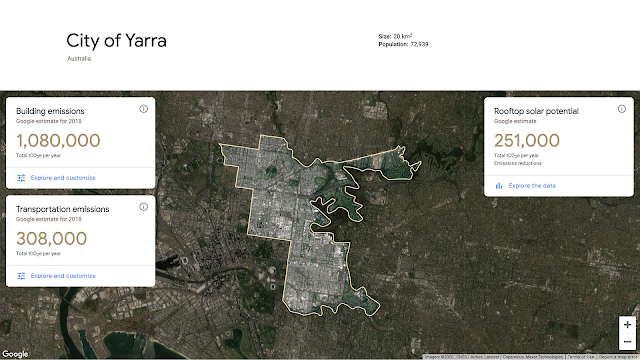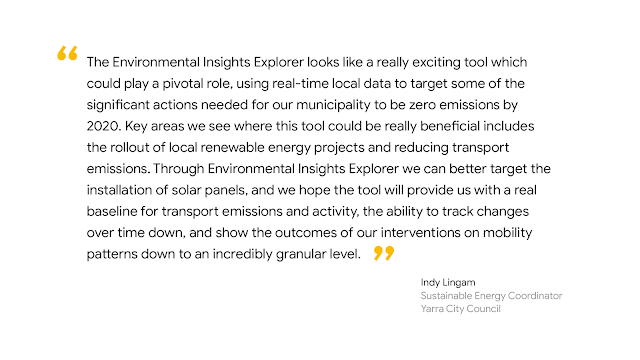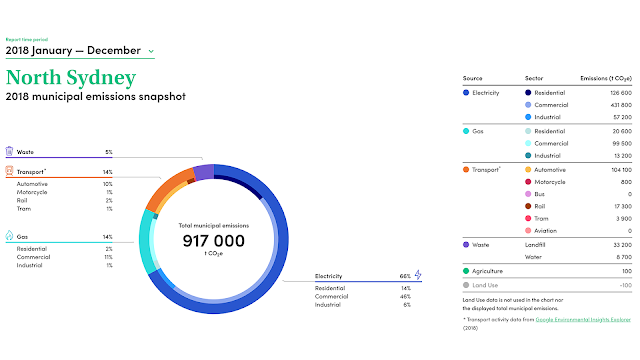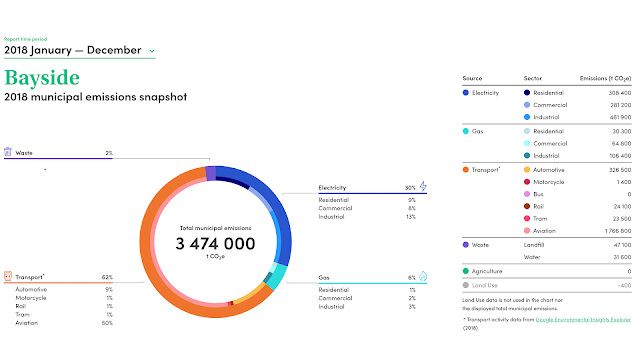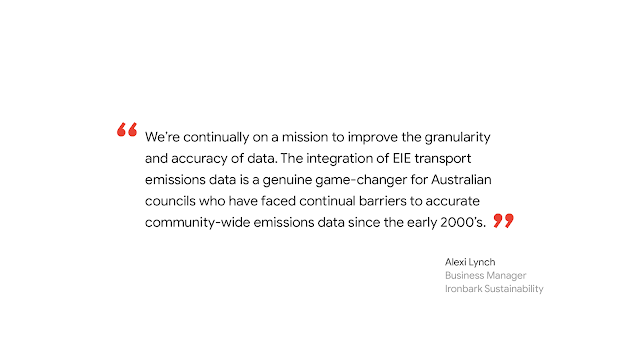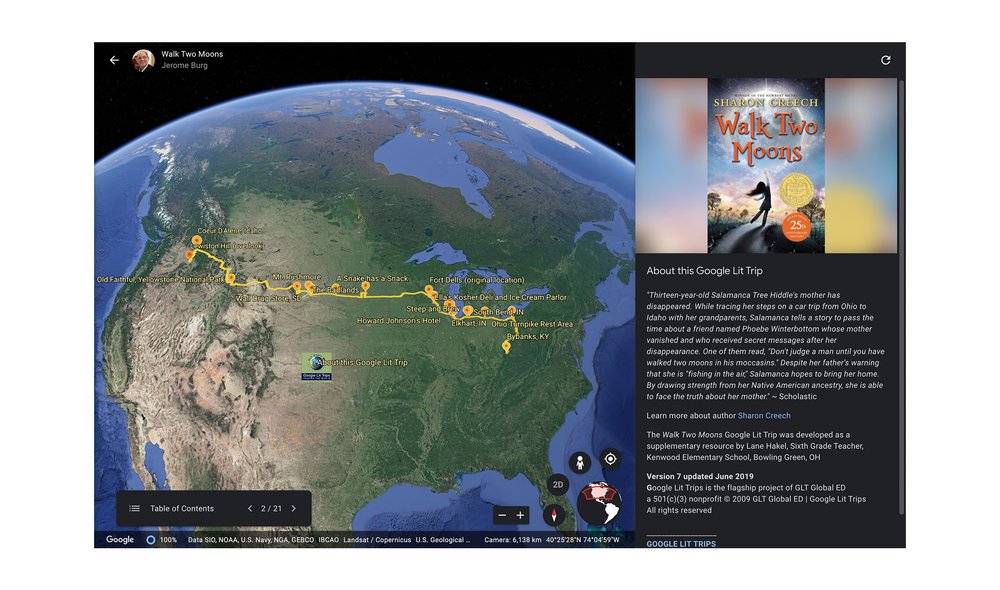Tag Archives: Google Earth
Environmental Insights Explorer Expands: 100 Australian councils and counting
Source: Official Google Australia Blog
Cities: where climate action can have the most impact
Cities bring people and ideas together. They increase living standards, spur innovation, increase opportunity, and encourage collaboration. Cities can also be the most environmentally sustainable way for people to inhabit our planet, if we can address the reality that cities are currently responsible for 70 percent of the world’s CO₂ emissions. While this may seem like an insurmountable challenge, it’s actually a tremendous opportunity. Cities can become centers of climate action, and lead the world in driving economic recovery and resilience.
As part of Google's most ambitious decade of climate action, we’re making a commitment to help more than 500 cities and local governments reduce an aggregate of 1 gigaton (that’s one billion tons) of carbon emissions per year by 2030 and beyond.
To do this, we'll empower city planners and policymakers with the Environmental Insights Explorer (EIE), a platform we developed by analyzing Google’s comprehensive global mapping data together with standard greenhouse gas (GHG) emission factors. Today, we’re expanding access to EIE, going from 122 cities with access to more than 3,000 cities worldwide—a 25-fold increase. We’re also partnering with leading organizations, like ICLEI and Ironbark Sustainability, to support local climate action planning.

Turning climate insights into action
For cities to make a meaningful impact in reducing their carbon emissions tomorrow, they need to know where they stand today.
Yet according to the Global Covenant of Mayors, an international alliance of nearly 10,000 cities and local governments committed to fighting climate change, less than 20 percent of cities are able to execute on their commitments to climate action due to a lack of time, resources and data. And with COVID-19 leaving many localities with reduced budgets and limited resources, it’s even harder to build out a baseline emissions inventory or a robust climate plan.
With Environmental Insights Explorer, cities can leapfrog the constraints associated with lengthy climate studies. Cities can use EIE’s anonymized, aggregated mapping data and emissions insights to easily estimate the carbon footprint of their buildings and transportation activities, as well as discover their solar energy potential. Information that once required complicated onsite measurements and months to compile can now be assessed virtually, helping cities dedicate their energies toward action.
Cultivating partnerships with climate action leaders and cities worldwide
When it comes to climate change, we all need to work together. Nonprofits, businesses, universities and other leaders play an important role in testing new ideas and partnering with cities to implement the ones that work.
We’ve collaborated with partners to scale data access. Leading organizations like Local Governments for Sustainability (ICLEI ) and Ironbark Sustainability are integrating EIE data into their own tools, helping digitize emissions measurement and planning. With EIE data, Ironbark Sustainability is automating how they provide greenhouse gas emission information to local government councils across Australia so decision-makers can target their climate action activities.
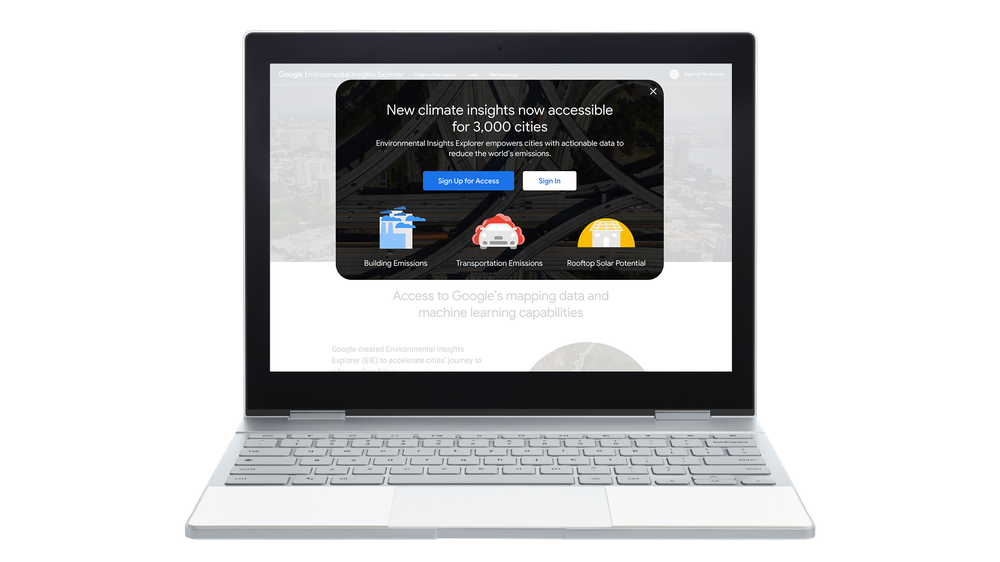
With the Insights Workspace dashboard in EIE, cities can review and evaluate emissions data. Data for more than 3,000 cities is freely available by registering for access at http://goo.gle/eie.
To help spark even more data-driven climate action, last year Google.org committed $4 million in funding to ICLEI Local Governments for Sustainability to create the ICLEI Action Fund. The fund awards projects from local organizations in Europe, Mexico and South America focused on using environmental datasets to reduce citywide emissions.
Today, ICLEI is announcing the first two selected projects. In Hamburg, HafenCity University is creating a tool to help the city identify spaces and districts that can be used as urban testbeds for prototyping sustainable mobility, building efficiency and solar energy development projects. In Monterrey, Mexico, Instituto Tecnológico de Monterrey received a grant to refine and amplify EIE data to help municipalities in the Monterrey region develop climate action plans. They’ll also use the data to run a model of traffic patterns in Monterrey to assess the electrification of a fleet of buses and how to optimize transit routes.
Supporting economic recovery and resilience with climate action
Efforts to combat climate change are both essential and a once-in-a-generation moment to create impactful jobs and modernize infrastructure. As communities are working to combat, and recover from, a global pandemic, reducing carbon emissions can and should support that recovery.
Already, cities and local governments across the world are using EIE to set bold climate action plans and support economic development:
The opportunity in front of us all
We’ve always viewed challenges as opportunities to be helpful and make things better for everyone. To build a better future and protect our planet, we’ll continue focused efforts that help our partners take climate action and strengthen investments in technologies to make a carbon-free world a reality.
Source: Google in Europe
Here’s to you: 15 years of Google Earth stories
We’ve always said that if Google Maps is about finding your way, Google Earth is about getting lost. With Google Earth, you can see our planet like an astronaut from space, then travel anywhere on it in seconds with a click or tap. Even after an entire afternoon exploring cities, landscapes and stories on Google Earth, you'll have barely scratched the surface.
Now 15 years old, Google Earth is still the world’s biggest publicly accessible repository of geographic imagery. It combines aerial photography, satellite imagery, 3D topography, geographic data, and Street View into a tapestry you can explore. But Google Earth is much more than a 3D digital globe. The underlying technology has democratized mapmaking allowing anyone to better understand our world, and take action to create positive change.
Of the billions of people who have used Google Earth over the years, here are 15 stories that have inspired us:
1. Responding to natural disasters. Two months after Google Earth launched, we quickly realized that people were not just using it to plan their vacations. Hurricane Katrina hit the Gulf Coast in August 2005, and the Google Earth team quickly worked with the National Oceanic and Atmospheric Administration (NOAA) to make updated imagery available to first responders on the ground to support rescue efforts, relief operations and understand the hurricane’s impact.
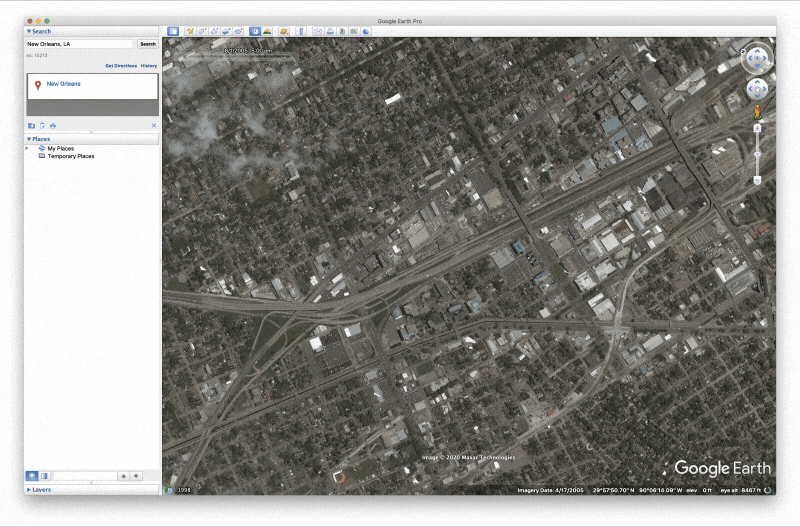
Hurricane Katrina imagery in Google Earth helped support rescue efforts, relief operations and understand the hurricane’s impact.
2. Taking virtual field trips. In 2006, former English teacher, Jerome Burg, first used Google Earth to create Lit Trips, tours that follow the journeys of literature’s well-known characters. Today the project includes more than 80 Lit Trips for teachers and students of all grade levels. Each tour includes thought-provoking discussion starters, classroom resources and enrichment activities.
3. Protecting culture. When Chief Almir of the Suruí people first glimpsed Google Earth on a visit to an Internet cafe, the indigenous leader immediately grasped its potential as a tool for conserving his people’s traditions. In 2007, Chief Almir traveled thousands of miles from the Brazilian Amazon to Google headquarters to invite Google to train his community to use Google Earth. The Suruí people went on to build their Cultural Map on Google Earth which included hundreds of cultural sites of significance in their rainforest.
4. Decoding animal behaviors. In 2008, German and Czech researchers used Google Earth to look at 8,510 domestic cattle in 308 pastures across six continents. The images led them to make the amazing discovery that certain species of cattle and deer align themselves to the magnetic poles while grazing or resting.

Scientists used Google Earth to find which species of cattle and deer align themselves to the magentic poles
5. Reuniting families. Saroo Brierley was accidentally separated from his family at the age of five and ended up in an orphanage. Luckily, Saroo was adopted by a loving family in Australia. As an adult, Saroo was curious about his origins and painstakingly traced his way back home to India using the satellite imagery in Google Earth. He was able to reunite with his biological mother in 2011 after 25 years apart. View the story in Google Earth.
6. Helping communities impacted by war. The HALO Trust—the world's oldest, largest and most successful humanitarian landmine clearance agency—uses Google Earth to identify and map mined areas. The HALO Trust has cleared 1.8 million landmines, 11.9 million items of other explosive remnants of war and 57.2 million of small arms munitions in 26 countries and territories around the world.

Two HALO staff in Nagorno Karabakh studying minefields with Google Earth.
7. Protecting elephants from poachers:To protect elephants from poachers seeking their ivory tusks, Save the Elephants built an elephant tracking system. Starting in 2009, they have outfitted hundreds of elephants with satellite collars to track their movements in real time on Google Earth. Their partner organizations, including rangers at the Lewa Wildlife Conservancy, use Google Earth in the fight against elephant poachers across the conservancy and privately owned rangelands in Kenya.
8. Discovering unknown forests. Dr. Julian Bayliss used Google Earth to explore high-altitude rainforests in Africa. For almost as long as Google Earth has existed, Dr. Bayliss has been systematically flying over northern Mozambique in Google Earth and scanning the satellite imagery. One day he came across what appeared to be a mountaintop rainforest. His virtual discovery set off a chain of events that led to the discovery of an untouched rainforest ecosystem atop Mount Lico in 2018.
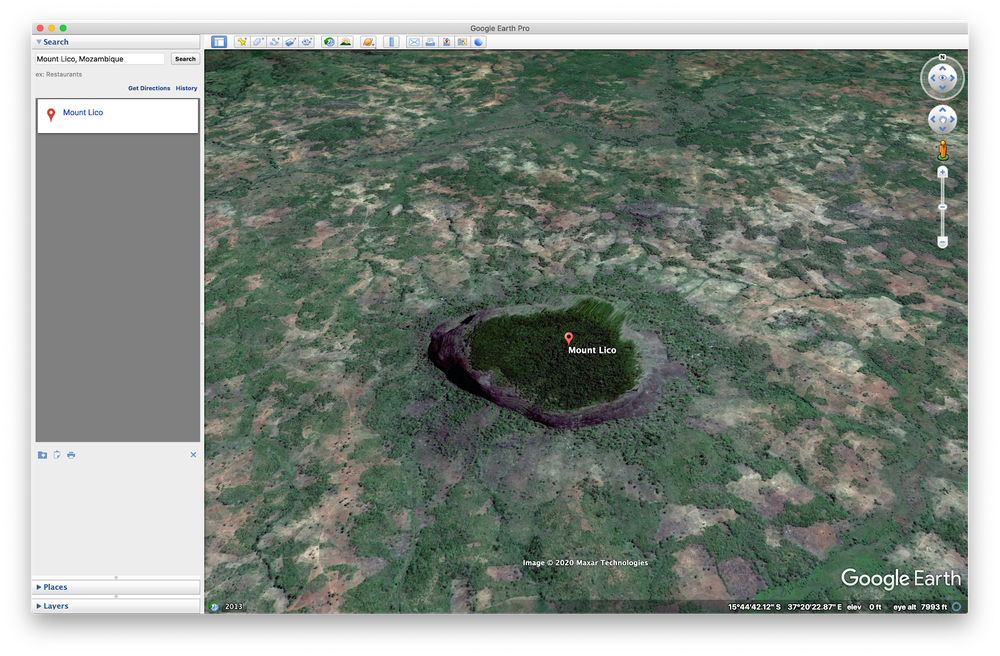
An untouched, mountain-top rainforest ecosystem is discovered with Google Earth.
9. Supporting students in rural classrooms. Padmaja Sathyamoorthy and others who work at the India Literacy Project (ILP) use Google Earth to build interactive content for rural classrooms, helping improve literacy for 745,000 students across India. Padmaja says, “ILP has made history and geography come alive with new tools and media content that capture the imagination of young minds. The project expands students’ horizons. It’s not just about learning curriculum from a textbook. I believe it creates a curiosity and a love for learning that will last a lifetime.”

10. Inspiring positive environmental change. The nonprofit organization, HAkA, used Google Earth to show threats to the Leuser Ecosystem, the last place on Earth where orangutans, rhinos, elephants and tigers coexist in the wild. This Google Earth tour helped raise awareness about the region and incited positive changes in the area.

HAkA's Google Earth tours have helped raise awareness about ecosystem threats in Indonesia.
11. Falling more in love with our planet. Google Earth VR, which was released in 2016, gave people the chance to see the Earth from a new perspective. Whether they experienced the overview effect or toured far flung locations, one thing remained constant — people couldn’t get enough.

You can soar over mountains with Google Earth VR.
12. Celebrating global language diversity. In 2019, Tania Haerekiterā Tapueluelu Wolfgramm, a Māori and Tongan woman traveled across the Pacific ocean to interview and record the speakers of 10 different Indigenous languages for Google Earth. The project featured 50 Indigenous language speakers from around the world in honor of the 2019 International Year of Indigenous Languages.
13. Catching (fictional) super thieves. People around the world followed the trail of Carmen Sandiego and the V.I.L.E. operatives by solving the three capers launched in Google Earth in 2019.
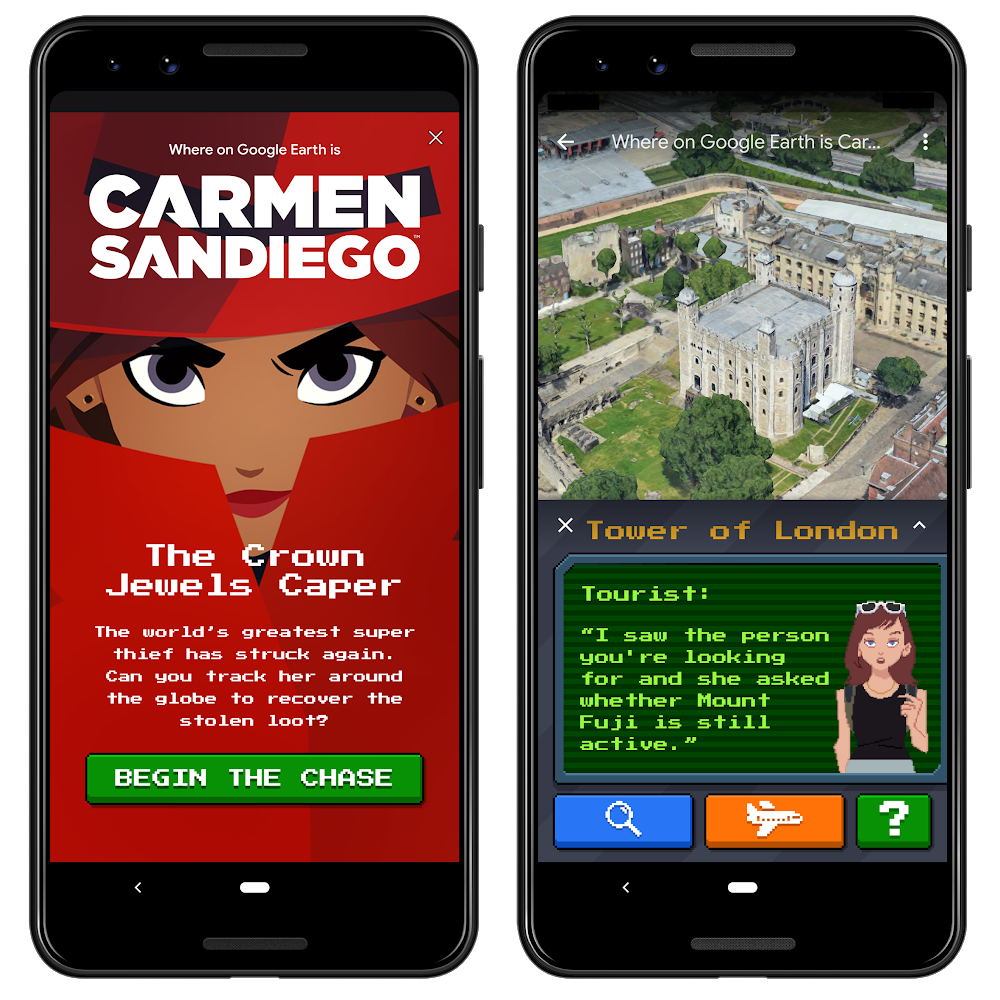
14. Telling more compelling news stories. Journalists have long used the rich imagery in Google Earth to create more engaging stories. Vox Video used Google Earth Studio to tell the story of how the Event Horizon telescope collected 54-million-year-old photons to take the first ever picture of a black hole.
15. Homecoming during COVID-19. During Golden Week in Japan, most people visit their hometowns, but this year that wasn’t possible due to COVID-19. To help homesick natives, a group from Morioka city developed a tour in Google Earth that let people virtually take the bullet train to Morioka station and visit beloved locations in the city.

Travel to charming Morioka, Japan in Google Earth, whether you're a traveller or native far from home.
A big thank you to everyone for being with us on this journey. Our hope is that Google Earth will continue to inspire curiosity and move us to care more deeply about our beautiful planet and all who live here. We look forward to seeing what the next 15 years brings!
Source: The Official Google Blog
Camp Google is now open
- Craft an engaging story using one of our many tools -- for example, tell a wildlife tale using Augmented Reality animals in Search
- Journey across India exploring the craft and traditions of our country on Google Arts & Culture
- Learn about our country’s natural resources and how to preserve them on Google Earth
- Get introduced to the world of programming, with Scratch (you don’t even need to write a single line of code!)
- … and plenty more!
Source: Official Google India Blog
Maps that bring us closer, even when we’re apart
With much of the world physically apart right now, people are finding creative ways to use custom-built maps to maintain a shared sense of community, albeit virtually.
In 2007, we launched a tool called My Maps to help people create their own custom maps on top of Google Maps. With a simple drag-and-drop interface you can add placemarks, draw lines and shapes, and embed text, photos and videos. You can share your map via public URL, embed it on websites or publish your map for others to see.
Over the past four months, we’ve seen a surge in the number of people creating and viewing My Maps. From December 2019 to April 2020, we saw nearly a billion more My Maps creations, edits and views compared to the same time period last year, growing from 2 billion to nearly 3 billion. With My Maps, communities have been sharing helpful, local information in rapidly changing situations—from COVID-19 testing sites and food banks to where first responders can access childcare facilities.
Maps can help us and our communities stay safe
A map can be helpful in ways that a simple list of text is not: it helps us instantly see information in the context of where we are, with the locations of the resources we might need.
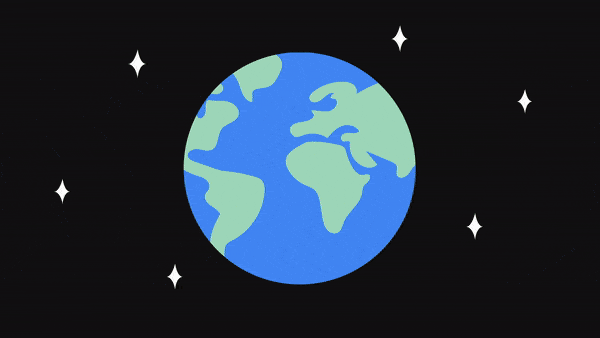
With My Maps, anyone can be a cartographer. People can import their own data into a custom map, similar to how the San Francisco Department of Homelessness & Supportive Housing mapped downtown hand-washing and hygiene stations to support hand hygiene and reduce the spread of COVID-19. With a spreadsheet or KML you can have your own custom map in no time.
Some maps take a bit more than hand-drawn points and polygons. For that, My Maps creators can import their own mapping data and mash it up with other sources.
For example, the online newspaper Briarcliff Daily Voice created a My Map showing the spread of coronavirus cases in the New York City metropolitan area, using data from three state healthcare agencies and the city’s health department. Pennsylvania.gov has leveraged My Maps to inform Pennsylvanians about coronavirus cases by county. And The Chicago Sun-Times has a map showing where to get tested for coronavirus in the Chicago area.
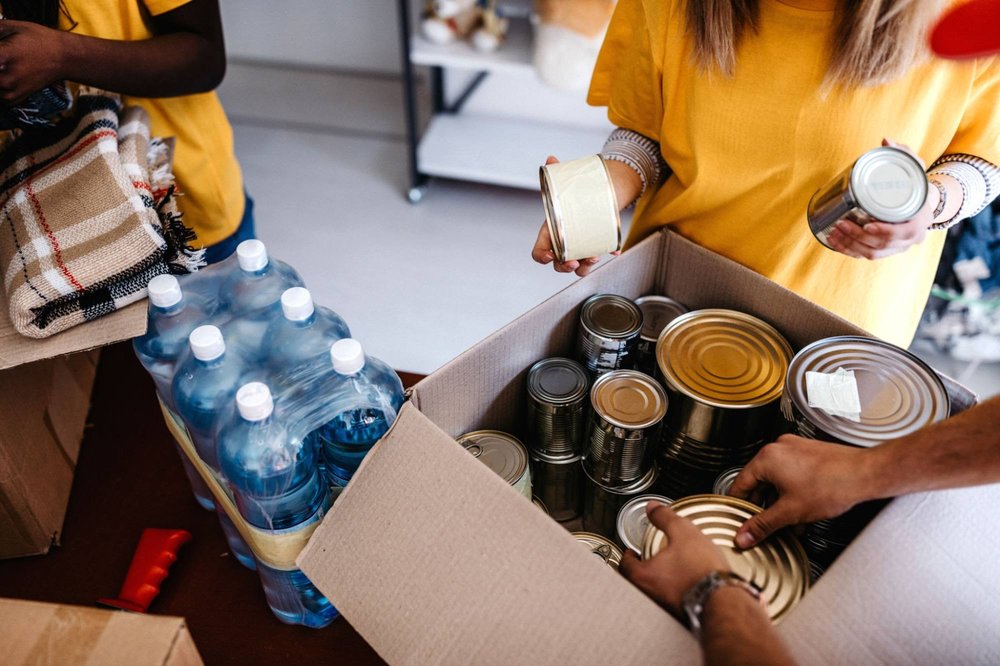
Anyone can be a force for good with simple, easy-to-use maps
In the past few months, we've seen how powerful this small set of relatively simple features can be. People are using My Maps to to be forces for good and coordinate relief efforts.
Map by map, people are connecting each other to resources for caring for ourselves and others, while staying healthy and informed. We’re seeing everyone from members of Congress to local nonprofits use Google My Maps to visualize information like school lunch pick-up spots to the spread of the virus in our communities.
Here are 10 helpful My Maps we’ve seen developed by communities around the world:
Keeping a shared sense of community, even when you're physically apart
As much as these maps are informative and helpful, they’re also uplifting. After a group of Brooklyn, NY moms asked neighbors to put pictures of rainbows in house windows so kids could track them down, one parent created a map showing the rainbows’ locations all over the city and suburbs. Now people worldwide are pitching in and adding their own rainbow locations to the map.
If you’d like to experiment with My Maps, we’re putting together tutorials on skills like merging datasets and embedding maps online. Visit the Google Earth Medium channel in the coming weeks to learn more.
Source: The Official Google Blog
Maps that bring us closer, even when we’re apart
With much of the world physically apart right now, people are finding creative ways to use custom-built maps to maintain a shared sense of community, albeit virtually.
In 2007, we launched a tool called My Maps to help people create their own custom maps on top of Google Maps. With a simple drag-and-drop interface you can add placemarks, draw lines and shapes, and embed text, photos and videos. You can share your map via public URL, embed it on websites or publish your map for others to see.
Over the past four months, we’ve seen a surge in the number of people creating and viewing My Maps. From December 2019 to April 2020, we saw nearly a billion more My Maps creations, edits and views compared to the same time period last year, growing from 2 billion to nearly 3 billion. With My Maps, communities have been sharing helpful, local information in rapidly changing situations—from COVID-19 testing sites and food banks to where first responders can access childcare facilities.
Maps can help us and our communities stay safe
A map can be helpful in ways that a simple list of text is not: it helps us instantly see information in the context of where we are, with the locations of the resources we might need.

With My Maps, anyone can be a cartographer. People can import their own data into a custom map, similar to how the San Francisco Department of Homelessness & Supportive Housing mapped downtown hand-washing and hygiene stations to support hand hygiene and reduce the spread of COVID-19. With a spreadsheet or KML you can have your own custom map in no time.
Some maps take a bit more than hand-drawn points and polygons. For that, My Maps creators can import their own mapping data and mash it up with other sources.
For example, the online newspaper Briarcliff Daily Voice created a My Map showing the spread of coronavirus cases in the New York City metropolitan area, using data from three state healthcare agencies and the city’s health department. Pennsylvania.gov has leveraged My Maps to inform Pennsylvanians about coronavirus cases by county. And The Chicago Sun-Times has a map showing where to get tested for coronavirus in the Chicago area.

Anyone can be a force for good with simple, easy-to-use maps
In the past few months, we've seen how powerful this small set of relatively simple features can be. People are using My Maps to to be forces for good and coordinate relief efforts.
Map by map, people are connecting each other to resources for caring for ourselves and others, while staying healthy and informed. We’re seeing everyone from members of Congress to local nonprofits use Google My Maps to visualize information like school lunch pick-up spots to the spread of the virus in our communities.
Here are 10 helpful My Maps we’ve seen developed by communities around the world:
Keeping a shared sense of community, even when you're physically apart
As much as these maps are informative and helpful, they’re also uplifting. After a group of Brooklyn, NY moms asked neighbors to put pictures of rainbows in house windows so kids could track them down, one woman created a map showing the rainbows’ locations all over the city and suburbs. Now people worldwide are pitching in and adding their own rainbow locations to the map.
If you’d like to experiment with My Maps, we’re putting together tutorials on skills like merging datasets and embedding maps online. Visit the Google Earth Medium channel in the coming weeks to learn more.
Source: Google LatLong
Maps that bring us closer, even when we’re apart
With much of the world physically apart right now, people are finding creative ways to use custom-built maps to maintain a shared sense of community, albeit virtually.
In 2007, we launched a tool called My Maps to help people create their own custom maps on top of Google Maps. With a simple drag-and-drop interface you can add placemarks, draw lines and shapes, and embed text, photos and videos. You can share your map via public URL, embed it on websites or publish your map for others to see.
Over the past four months, we’ve seen a surge in the number of people creating and viewing My Maps. From December 2019 to April 2020, we saw nearly a billion more My Maps creations, edits and views compared to the same time period last year, growing from 2 billion to nearly 3 billion. With My Maps, communities have been sharing helpful, local information in rapidly changing situations—from COVID-19 testing sites and food banks to where first responders can access childcare facilities.
Maps can help us and our communities stay safe
A map can be helpful in ways that a simple list of text is not: it helps us instantly see information in the context of where we are, with the locations of the resources we might need.

With My Maps, anyone can be a cartographer. People can import their own data into a custom map, similar to how the San Francisco Department of Homelessness & Supportive Housing mapped downtown hand-washing and hygiene stations to support hand hygiene and reduce the spread of COVID-19. With a spreadsheet or KML you can have your own custom map in no time.
Some maps take a bit more than hand-drawn points and polygons. For that, My Maps creators can import their own mapping data and mash it up with other sources.
For example, the online newspaper Briarcliff Daily Voice created a My Map showing the spread of coronavirus cases in the New York City metropolitan area, using data from three state healthcare agencies and the city’s health department. Pennsylvania.gov has leveraged My Maps to inform Pennsylvanians about coronavirus cases by county. And The Chicago Sun-Times has a map showing where to get tested for coronavirus in the Chicago area.

Anyone can be a force for good with simple, easy-to-use maps
In the past few months, we've seen how powerful this small set of relatively simple features can be. People are using My Maps to to be forces for good and coordinate relief efforts.
Map by map, people are connecting each other to resources for caring for ourselves and others, while staying healthy and informed. We’re seeing everyone from members of Congress to local nonprofits use Google My Maps to visualize information like school lunch pick-up spots to the spread of the virus in our communities.
Here are 10 helpful My Maps we’ve seen developed by communities around the world:
Keeping a shared sense of community, even when you're physically apart
As much as these maps are informative and helpful, they’re also uplifting. After a group of Brooklyn, NY moms asked neighbors to put pictures of rainbows in house windows so kids could track them down, one parent created a map showing the rainbows’ locations all over the city and suburbs. Now people worldwide are pitching in and adding their own rainbow locations to the map.
If you’d like to experiment with My Maps, we’re putting together tutorials on skills like merging datasets and embedding maps online. Visit the Google Earth Medium channel in the coming weeks to learn more.
Source: The Official Google Blog
Sustainable living tips for life at home
At Google, sustainability starts at home. We strive to build sustainability into everything we do. Today, we shared that we matched 100% of our energy use with renewable energy purchases for the third year in a row. On Earth Day and every day, we are committed to helping everyone build a more sustainable world, and part of that means making it easier for everyone to make environmentally friendly choices. According to Google Trends, over the past 90 days search interest in “How to live a sustainable lifestyle” has increased by more than 4,550%. To celebrate Earth Day while many of us are finding our new normal while sheltering in place, I wanted to share some of my favorite simple sustainability tips.
Save the planet, save some money
If I told you that putting your groceries away in the right place, freezing your leftovers, using the dishwasher (instead of washing dishes by hand) and turning down your water heater just a few degrees could help protect the environment, you might think that sounds too simple. But our greatest impact on the planet comes from just three things: food, water and energy usage. If we each make a few small changes, we can all make a big difference (and save money while we’re at it). Our Your Plan, Your Planet tool has more simple tips you can use in your home.

Advice from Nest and Assistant
Nest Thermostat owners have saved over 50 billion kilowatt hours of energy since we first introduced the device, which comes to $3 billion in energy bill savings. In honor of Earth Day, the Google Assistant can help you save even more. Just say “Hey Google, give me an Earth Day tip” for simple ways you can save energy, like changing the temperature on your Nest Thermostat by just a few degrees until the leaf symbol pops up, so you know you’re saving energy.
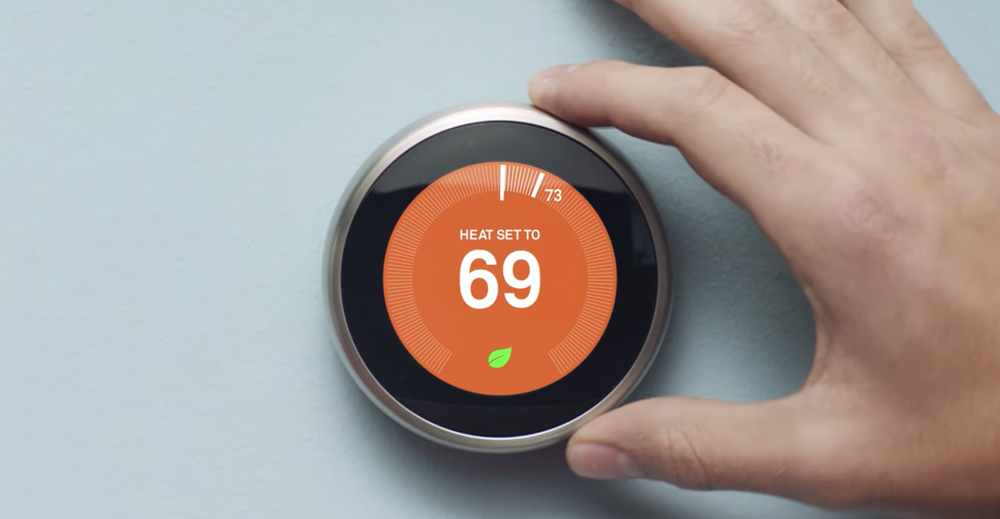
Get the buzz on bees from today’s Doodle
See what all the buzz is about in today’s interactive Earth Day Doodle, made in collaboration with The Honeybee Conservancy. Guide your bee to pollinate flowers while learning fun facts about bees and how they help the planet. Even while social distancing, there are several things you can do to help, like supporting your local beekeeper, planting a pollinator garden or creating a bee bath.

A little “how to” help
Recently, we’ve seen a spike in “how to” sustainability queries related to food, recycling and composting. If you’re in the U.S. or Canada, you can ask your Google Assistant how to recycle specific items and you’ll get local city and town specific answers. You can also check out our curated YouTube Earth Day playlist where you can learn how to compost, fix old clothing or turn those leftovers into a new meal.
“How to freeze” has been a particular popular question. Here are a few of the answers I found particularly helpful:
How to freeze milk? Place the milk in your freezer in its original plastic container or glass freezer-safe container. Make sure to leave room to allow the milk to expand, so remove some milk if needed. When you're ready to use the frozen milk, allow it to thaw in the fridge.
How to freeze eggs? To freeze whole eggs, you simply mix the eggs together and pour the mixture into either an ice cube tray, or a freezer-safe container or bag. If you will need to use individual eggs, it would make more sense to make sure each ice cube tray holds only one egg so that you can easily separate them.
How to freeze broccoli? Broccoli—florets and stems—must be blanched for effective freezing. If you freeze it raw, you'll wind up with bitter, drab green, shriveled stems. Blanching or steaming preserves the bright green color and tasty flavor. You can either blanch in boiling water for three minutes or steam for five minutes.
Enjoying planet Earth from wherever you are
With travel plans paused, national parks temporarily closed and a collective effort to stay socially distant, the world feels a bit out of reach right now. While there’s no substitute for the real thing, virtual vacations are a great way to experience our planet from wherever you are sheltering in place using Google Earth.
If you’re seeking natural beauty, explore the most enchanting forests, striking waterfalls, or unusual lakes around the globe. For those interested in the other creatures that share our planet, learn about the kākāpō, sea turtles or humpback whales. For anyone interested in a more scientific journey, learn about the ecosystems of the world, understand the impact of keystone species on their habitats, or learn how to be a scientist in your backyard—all you need is your smartphone.
I hope these tips are an easy way to get started. At Google, we know that individual actions collectively can make a big difference, and we’re happy to support everyone on their journey to a more sustainable life.
Source: The Official Google Blog
Explore new sites, relive old hikes for National Park Week
Every year, I try to visit a new National Park, or at least start planning my trip to one. That’s a little more difficult right now, but given that it’s National Park Week, I decided to try and keep with my tradition by using Google tools to satisfy my wanderlust.
Explore new places and parks
This year, I’m heading to g.co/nationalparks, a Google Arts & Culture project developed in collaboration with National Park Service that takes you on guided tours narrated by park rangers from the Kenai Fjords, Hawai'i Volcanoes, Carlsbad Caverns, Bryce Canyon and Dry Tortugas. I can also visit historical sites that I’ve never been to before, like Eleanor Roosevelt’s woodsy home in Hyde Park, New York or Thomas Edison’s camping sites (which, to me, look a little more like glamping). There are more than 100 Street View historical tours to choose from, and collections that let you discover Native American craft work or fossils from archeological digs.
Afterward, I’ll take an in-depth tour of some of the National Parks of the United States and wander through a few of the most-loved ones recommended by our community of Local Guides in two popular Google Earth Voyager stories. I plan on rounding out the week with a new YouTube series from the Google Earth team that travels to National Parks across the country, literally “zooming” you into places like Elephant Hill in Canyonlands National Park and Kanarraville Falls in Zion National Park. There’s even a new Global National Parks quiz to test your geo-knowledge.
All of these things help an outdoor enthusiast who’s stuck inside (for the time being) to find unknown landscapes or get inspiration for their next trip. Perhaps for the most well-traveled out there, they’re a way to remember a favorite adventure.
Or revisit old favorites
Before I venture into the unknown, I decided to take a trip down memory lane (or rather, memory trail), and re-experience some of my favorite hikes in National Parks with the help of Google Street View, and anyone can join me—starting with Bright Angel Trail in the Grand Canyon. Saving the uphill journey for the second half of a hike is something my legs will never forget, but it remains one of my favorite National Parks memories. And thanks to Street View, I can recreate the journey … with fewer water breaks, probably.
I can also make my way up Garfield Peak in Crater Lake National Park (which I hiked during a camping trip where I first met my husband) and make as many nostalgic pit stops along the way as I want.
And last summer, my family and I all vacationed in Acadia National Park. Now that we can’t physically see one another, I’m even more grateful we went. One of my favorite memories was hiking along the park’s easternmost edge, the Great Head Trail, with my husband and meeting my family on Sand Beach, a journey I’m happily retaking via Street View … and maybe on our weekly family video call, we’ll all “hike” it together.
